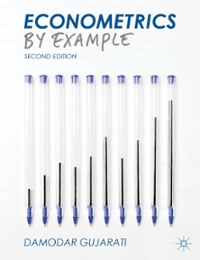Question
m microeconomics,, Suppose that doctors must choose a level of care, x, for each of their patients. The cost of such care is c(x) =
m microeconomics,,
Suppose that doctors must choose a level of care, x, for each of their patients. The cost of such care is c(x) = 5x2 +5. The benefit of care (translated into dollars) is f(x) = 90x10x2. Suppose doctors have utility functions given by U(x) = (1 )P(x) + f(x) c(x) where P(x) is the monetary payment the doctor receives from treating a patient with x units of care. Doctors care about a weighted average of their own monetary revenue from care P(x) and the patient's benefit f(x), with the weight given by the parameter [0, 1]. 1. What is the optimal level of care, x?
2. Suppose that the Medicare system begins with retrospective payments. Under this scheme, doctors choose whichever level of x they feel is appropriate, and then the Medicare program gives the doctors $40 for every unit of x that they prescribe. (a) Under these incentives, what amount of care will each doctor prescribe? How does your answer depend on ? To what does = 0 correspond? To what does = 1 correspond?
(b) In general, is the level of care too high or too low (the answer may depend on )? Why?
3. Now suppose that the Medicare system switches to a prospective payment system. For our purposes, let's say that the prospective payment system compensates doctors by a fixed payment provided that x x, where x is some level set by the Medicare administrators. That is, the prospective payment system gives doctors a fixed dollar amount per patient, but requires that doctor's provide at least a certain amount of care. (a) If the Medicare prospective payment system wants doctors to provide precisely the optimal level of care, what will they set as x?
(b) Provided that Medicare wants doctors to care for all patients (and not send patients away), what should they set as ?
(c) Demonstrate mathematically how doctors have limited incentive to provide care beyond x
(d) Show that the total health benefits under this system are actually slightly smaller than those for under retrospective payment.
4. In reality, health economists found that PPS lowered costs and had little effect on actual health outcomes. Explain why this happened, citing the results above.
5. Now suppose that that there are two types of patients divided into two diagnosis related groups (DRGs). Some patients are "serious" cases (S), and the other patients are "not so serious" (N). The cost of care is as above. Suppose further that the Medicare system compensates doctors with N = 10 for xN 1; and S = 60 for xS 3. (a) Calculate a doctor's profits for each type of patient.
(b) If doctors can re-label patients describe what will happen.
(c) How did "DRG Creep" undo some of the gains of PPS, both in this model and in reality?
You have been hired by the Commonwealth of Massachusetts to evaluate a welfare reform put in place by the state, which made it very unpleasant to be on welfare by imposing harsh training requirements on those in the program. Specifically, Massachusetts wonders if the harsher requirements induced women to supply additional labor supply, and hence earn more in labor income. Welfare is only available to single mothers in the state. Welfare was reformed for residents of Boston in 2005, but not for residents of Springfield (a town in western Massachusetts) until 2007. For your evaluation, you are provided the following data on the average monthly earnings of different groups of women in the two cities for two years, 2004 and 2006. City Year Marital Status Labor Income Boston 2004 Single 175 Boston 2004 Married 300 Boston 2006 Single 210 Boston 2006 Married 290 Springfield 2004 Single 120 Springfield 2004 Married 200 Springfield 2006 Single 125 Springfield 2006 Married 210 1. Propose two difference-in-difference estimators of the impact of the 1995 welfare reform in Boston. For each, give: (a) The assumptions required for the DD estimator to be valid. (b) A scenario under which the assumptions would be violated.
2. Which of these two estimators do you prefer, and why?
3. You are worried that the state will not believe the assumptions underlying your estimators above. (a) Propose another estimator that holds under more general assumptions, and construct this estimator.
(b) Explain the assumptions required for your estimator in 3(a) to be valid.
(c) Give a scenario under which the assumptions in 3(b) would be violated.
(d) Based on your DD estimates and your estimate in 3(a), was the welfare reform successful in increasing the labor earnings of single Boston women?
Step by Step Solution
There are 3 Steps involved in it
Step: 1

Get Instant Access to Expert-Tailored Solutions
See step-by-step solutions with expert insights and AI powered tools for academic success
Step: 2

Step: 3

Ace Your Homework with AI
Get the answers you need in no time with our AI-driven, step-by-step assistance
Get Started


